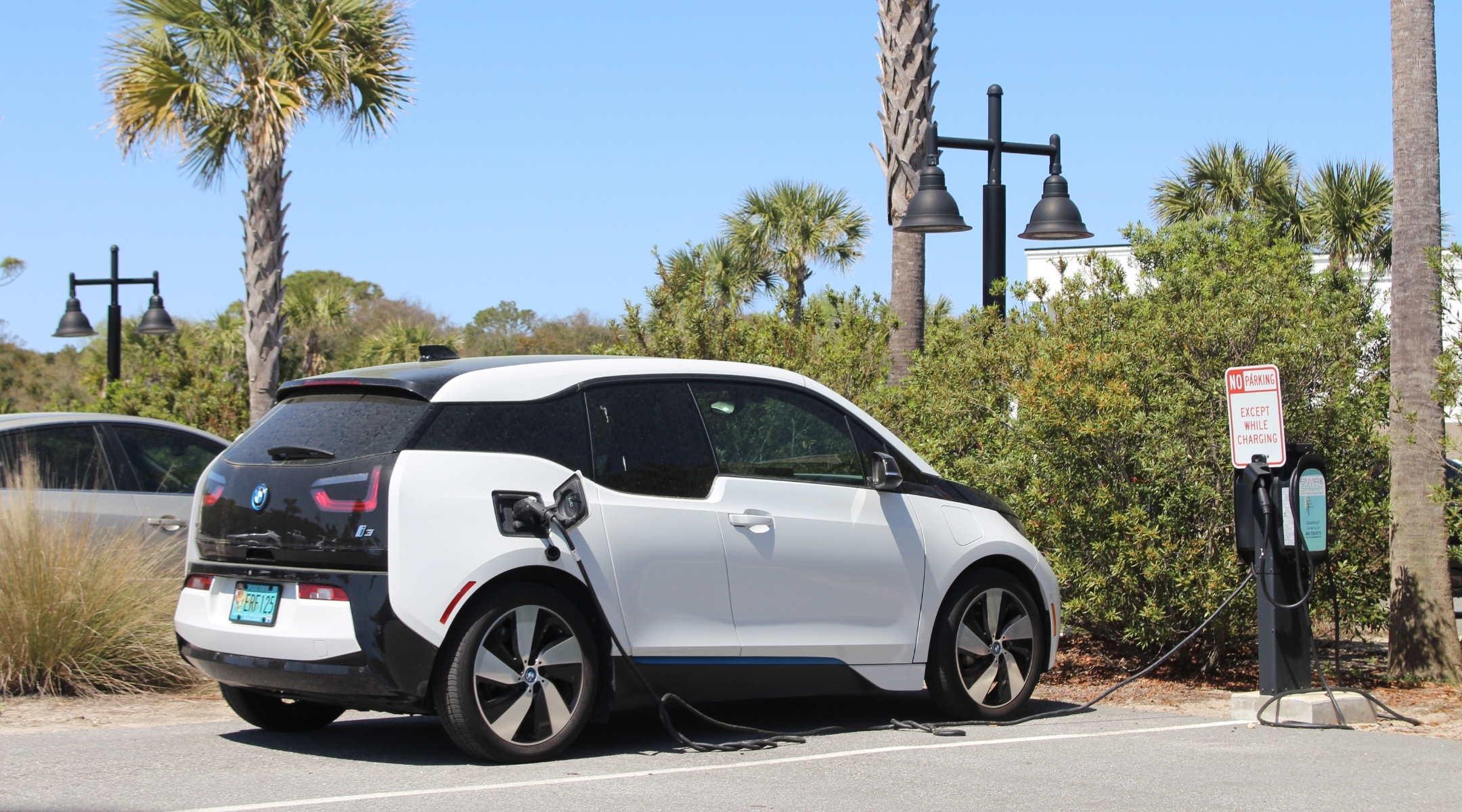Conservative rabbis endorse use of electric cars on Shabbat, but divisions over driving remain
The vote was 10 in favor, six against, five abstained.

An electric car charges in a station. (Wikimedia Commons)
(JTA) — When rabbis from the Conservative movement got together to decide whether it is permissible to drive electric cars on Shabbat, their conclusion might have been obvious.
After all, the Conservative movement famously adopted an opinion in 1950 saying that driving to synagogue on Shabbat is acceptable for Jews who have no other way to get there. And in 2012, the movement adopted an opinion saying that the use of electricity in activities that are permitted on Shabbat is acceptable according to Jewish law or halacha.
And yet the ultimate vote to permit the use of electric cars on Shabbat was deeply divided, with just 10 members of the movement’s 25-rabbi Committee on Jewish Law and Standards voting in favor and six voting against. Five rabbis abstained from voting. (All 25 rabbis need not attend a vote; six or more votes are needed to approve a paper.)
What’s more, the committee adopted a second, competing opinion, known as a responsum, outright rejecting the use of electric cars on Shabbat — by a very similar margin.
Two rabbis, including one of the committee’s co-chairs, voted for both papers, even though the responsa came to different conclusions.
“Both of these responsa articulate the preference for walking to and from the synagogue on Shabbat, and the more of us Jews who can do that, the better, not only for halakhic reasons, but also for creating a close-knit community on Shabbat,” Rabbi Elliot Dorff wrote to explain why he voted for both positions. “That said, Jewish law must be applied to the realities that Jews face.”
It’s not unusual for the committee, whose rulings guide the movement’s rabbis, to adopt competing opinions, as it did, for example, when ruling in 2006 on inclusion for gay and lesbian Jews.
The groundwork for the split rulings, published on Wednesday, was laid in a footnote to the 2012 ruling on electricity. “Those who accept the 1950 CJLS minority position permitting people to drive to synagogue in a gas powered car would be justified extending this permission to electric cars,” the opinion’s author, Rabbi Danny Nevins, wrote — implying that at least some in the movement rejected the 1950 decision.
Before the 1950 responsum, Orthodox and Conservative groups agreed that driving was prohibited on Shabbat, citing halacha, or Jewish law, that forbids a host of activities on the day of rest, including lighting a fire and traveling a long distance from one’s home. The 1950 responsum was a landmark in American Judaism because it effectively sanctioned the choices of many Jews who had moved to suburbs where walking to synagogue was all but impossible. In fact, the responsum did not say that driving to synagogue was halachically sound, only that it was a concession worth making to facilitate the public and communal observance of Shabbat.
Nearly 75 years later, the leniency reflects the practices of most Conservative congregants in the United States, but Conservative rabbis and institutions largely have not accepted it. The Jewish Theological Seminary, the movement’s flagship seminary, bars rabbinical students from traveling by car on Shabbat, for example, and the Conservative movement in Israel rejected the position fully.
The challenges to the use of cars on Shabbat according to Jewish law are extensive: One might travel beyond the borders of one’s community, for example, or be tempted to perform repairs, both prohibited on Shabbat. But the biggest obstacle for the cars that most American Jews were driving in 1950 and today is that gas-combustion engines create fire in the course of ignition.
The rise of the electric car offers a widely accessible way to drive without creating fire. Concerns about driving too far or needing repairs still apply, write the authors of the paper making the case for electric cars on Shabbat, but by sticking close to home and driving only for Shabbat-related reasons, Jews can use electric cars without violating Shabbat.
That paper was written by two rabbis with recent experience in U.S. pulpits, David Fine of Temple Israel in Ridgewood, New Jersey, and Barry Leff, who divides his time between Israel and the United States and recently completed an interim stint at a synagogue in Birmingham, Alabama.
“For those who drive to the synagogue on Shabbat, driving an all-electric car is preferable to driving a conventional car,” they write. But they add, “When possible, we encourage walking or riding a bicycle as they are at a slower pace and more conducive to the spirit of Shabbat.” (Looking ahead, they also note that self-driving cars are permitted, saying, “The more that can be taken out of direct human hands, the more the spirit of Shabbat is constructed and preserved. If the technology and capability of an autonomous driving car is available and safe and able to transport one to synagogue, then all the better.”)
The paper rejecting driving on Shabbat altogether was written by two rabbis who do not work in synagogues: Marcus Mordecai Schwartz, who heads the study center at JTS, and Chaim Weiner, the head of Masorti Europe, the movement’s network of European congregations. They say they wanted to make sure that Conservative Jews who hold more traditional views about Jewish law — and who never accepted the 1950 ruling on Shabbat driving — could see their values in the movement’s legal literature.
“Some may think that we are attempting to exclude the less strictly-observant members of our communities,” they write. “Nothing could be further from our aim.”
Practically speaking, the impact of the legal opinions about electric cars is limited. Conservative congregants mostly drive to synagogue when they go — though the number of Jews affiliating with those synagogues is down sharply in recent decades, according to survey data. Few rely on the movement’s legal rulings to guide their daily activities.
But the rulings are influential among the movement’s rabbinic corps. And they can offer broad and needed messages, according to Rabbi Pamela Barmash, a professor at Washington University in St. Louis who chairs the CJLS with Dorff.
Barmash voted for the anti-driving opinion and abstained from voting on the one permitting electric cars on Shabbat. She said she wanted both positions to be available to Conservative Jews who are thinking about how to observe Shabbat.
“What is inspiring this is to emphasize the centrality of Shabbat to our lives as Jews, to our synagogue communities, and our personal relationships with God,” she said. “Restoring Shabbat and emphasizing Shabbat as so central is all the more urgent in the 21st century.”
This article originally appeared on JTA.org.





















